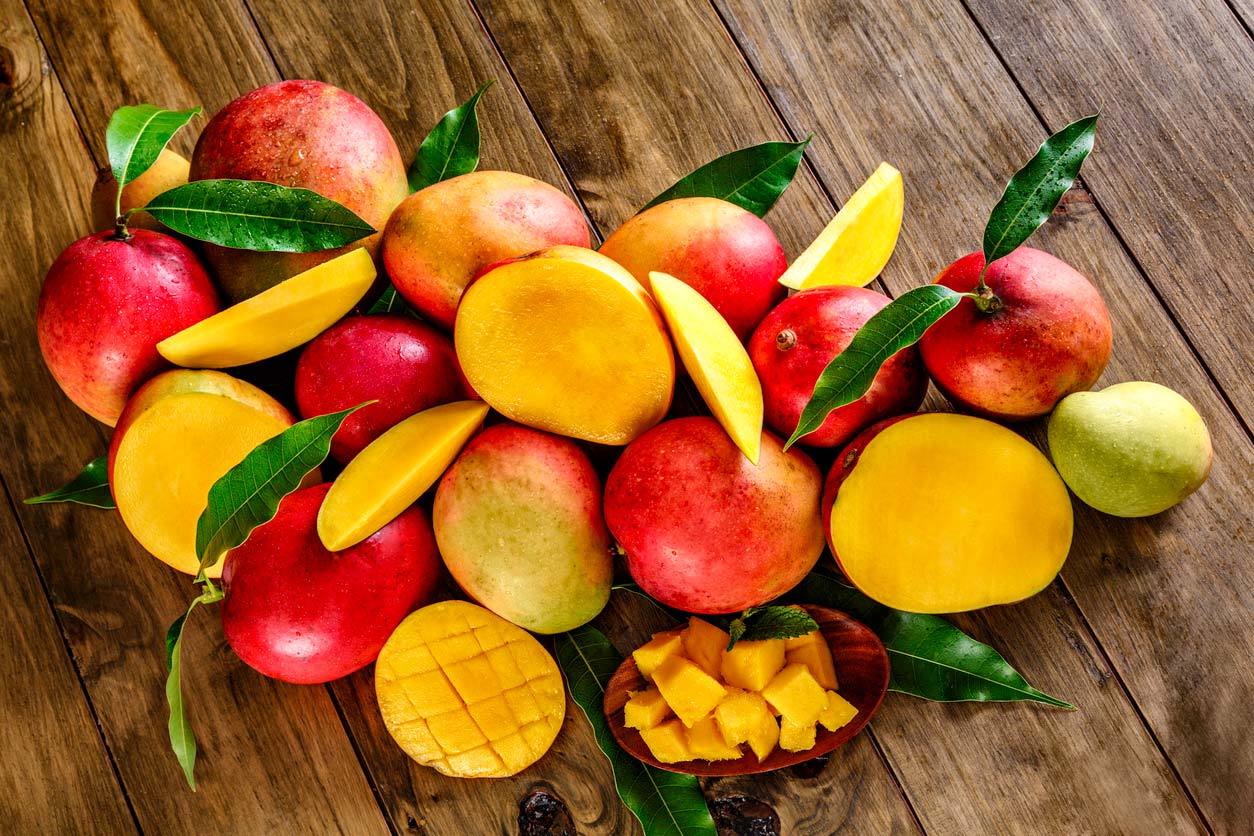Mangoes are a stone fruit, like peaches, plums, and cherries. The official biological
name for such a fruit is a drupe, which might come in handy in a tight game of Scrabble. The mango tree, whose botanical name is Mangifera Indica, is part of a pretty intense family, the Anacardiaceae. Other members include cashews and sumac, along with our good friends poison ivy and poison oak. All these plants can cause allergic reactions in humans, thanks to the oily compound urushiol found in their sap.Mangoes come in a variety of types and colors, and their taste varies depending on variety as well as the degree of ripeness. Typically, mangoes are sweet and juicy, with varying degrees of tartness. Some folks describe their flavor as similar to those of peach, pineapple, and apricot, although as someone who’s eaten plenty of all these fruits, there’s no way to compare one to another. Some things just don’t translate into words, and the taste of a ripe mango is one of them.
While there are over 1,000 varieties of mango growing worldwide (including the evocatively named “huevos de toro,” which should not prove too esoteric to anyone who’s taken high school Spanish), we see six main types in US grocery stores. And given the mango’s storied pedigree, the names are pretty bland: Honey (also known as Ataulfo), Francis, Haden, Keitt, Kent, and the dominant variety in the UK and US, Tommy Atkins, which sounds more like a boy band member than the world’s best-selling mango, but what do I know?
Other varieties that pop up from time to time include Alphonse, Edward, Kesar, Manila, and Palmer (which, I’m sorry to report, was not named after the legendary golfer, Arnold Palmer).
Mango Nutrition

Like most whole plant foods, mangoes are nutrient-dense. They’re high in many vitamins, especially A, C, and B6. And they contain a small amount of protein, as well as some copper and potassium. Their heightened sweetness indicates that mangoes are high in calories and carbohydrates (which is why our ancestors’ preference for sweets, which most of us have inherited, was such an important survival mechanism).
With all those natural sugars, you might think they’re a no-no for people with diabetes, or anyone wanting to avoid spiking their blood sugar. But raw mango ends up mid-range on the glycemic index (51 out of 100) because of its high fiber content. In fact, one cup of raw mango provides three grams of fiber, which fulfills 12% of the US recommended daily intake.
Benefits of Mangoes

So are mangoes good for you, then? Researchers are discovering more and more health benefits of mangoes all the time. Both in laboratory assays and in clinical trials, mangoes are dazzling scientists with the breadth of their positive impacts.
Anti-inflammatory
For one thing, mangoes appear to be highly anti-inflammatory. In a study that I find ethically disturbing, mice who were given ulcerative colitis experienced an improvement in symptoms when given extracts of the mango fruit itself, as well as a compound found in the tree’s stem bark.
Other studies found that enzymes in the fruit were protective against ulcers in both mice and rats. Given how many humans already suffer from these conditions, and that rodent trials don’t always correlate to human results, it sure would be nice if we conducted clinical trials with people eating actual mangoes. We’d reduce animal suffering and possibly human suffering as well.
High in Antioxidants
Mangoes contain high concentrations of both ascorbic acid (vitamin C) and various polyphenols, which are phytonutrients — nutrients found in plants — that have a host of positive effects. One such polyphenol specific to mangoes is mangiferin, which helps reduce iron overload (again, in rats and mice), and could be a useful addition to the diets of people with hemochromatosis (a condition that often produces excessive iron in the blood).
Other antioxidant compounds found in mangoes may prevent oxidative stress (think of rusting, except inside your body rather than that old bike frame you left leaning against the garage for four years), and may actually repair oxidative damage related to aging, cancer, atherosclerosis, heart attack, stroke, and diabetes. No, it won’t work on a bike frame, but the human body is pretty miraculous.
Anticancer Properties
Mangoes may have powerful anticancer effects on tumor cells. Now we move from the world of animal studies to the test tube, where cancer cells and potential anticancer compounds fight it out under the bright glare of science. In these contests, mango extracts keep coming out on top.
A team from Texas found that compounds found in mangoes killed tumor cells in multiple types of cancer, including pancreatic, cervical, colorectal, and breast. Notably, the compounds triggered apoptosis (cell death) in the cancer cells, but not in healthy human cells. One caveat: the studies were all funded by the National Mango Board, which doesn’t negate the results, but suggests that the studies need to be replicated by researchers without any potential conflicts of interest.
Diabetes Treatment & Prevention
Remember how one of the supposed problems with mangoes is their high sugar content? You might expect such a fruit to wreak havoc with the blood glucose of someone suffering from diabetes. But you’d be wrong. It turns out that, in rat studies, at least, mango consumption actually decreases blood glucose levels. This puts the fruit in the same category as a bunch of anti-diabetic drugs. But in the case of the mango, the blood sugar heroes appear to be the polyphenols, carotenoids (another family of phytonutrients found in orange-hued plants), and high fiber content.
Not everyone reacts the same way to particular foods, so you’ll want to see for yourself the effects of mango consumption on your blood sugar if that’s a concern. Start by sticking to a single serving. And if you have a condition that requires blood sugar monitoring, test your blood sugar after eating to see how your body responds. Keep in mind that mango juice may have a different effect than eating whole fruit pieces. When fruits are pulverized and their fiber is removed, the absorption of sugars happens much quicker.
What about dried mango? Any time you try dried fruit, you’re removing most of the water from it, which concentrates both the nutrients and the sugars. As such, unsweetened dried mangoes are an even richer source of fiber and antioxidants — and they can also taste even sweeter. In general, their glycemic load is considered similar to that of fresh mangoes although some researchers say it might be a bit higher.
Some dried mango also comes with added sugar. Why anyone would add sugar to such a sweet fruit is beyond me, but if that’s the case, then as far as I’m concerned, it ceases to be a healthy food and becomes more of a candy.
May Protect Your Skin
It’s poetically fitting to think that a fruit with such smooth skin might help protect your skin, too. That is, the mango might help protect you from UV radiation damage caused by the sun. What we know, thanks to a 2013 study out of an anti-aging laboratory in Korea, is that mango extract reduced and to some extent reversed the effects of UVB radiation on a group of hairless mice.
When it comes to preventing wrinkles, things get more complicated. The good news is, in 2020, we finally got a study on the effects of mangoes on humans, as opposed to rodents. The better news is, the humans consented to participate in the study. And the best news is… Sixteen weeks of daily doses of 85 grams (about ½ cup) of ataulfo mango reduced wrinkle size and severity in a group of postmenopausal women. The bad news is, the effect was dose-dependent, with the group that consumed the largest amount (250 grams, which comes to more than 1 ½ cups of mango per day) experiencing greater wrinkle length and severity. (So there you go, apparently, you can have too much of a good thing.)
It’s unclear what caused the 250-gram group’s worsening wrinkles. The researchers were clearly confused by the unexpected finding and speculated that the high sugar content of the larger amount of mangoes may have caused glycation of collagen fibers (basically, they get sticky and glom together), which made the wrinkles grow. Since both groups were on a roughly 1,700 kcal/day diet, I also start to wonder if the group eating more mangoes compensated for the extra mango calories by cutting back on other foods that are also skin-protective in other ways.






Комментариев нет:
Отправить комментарий